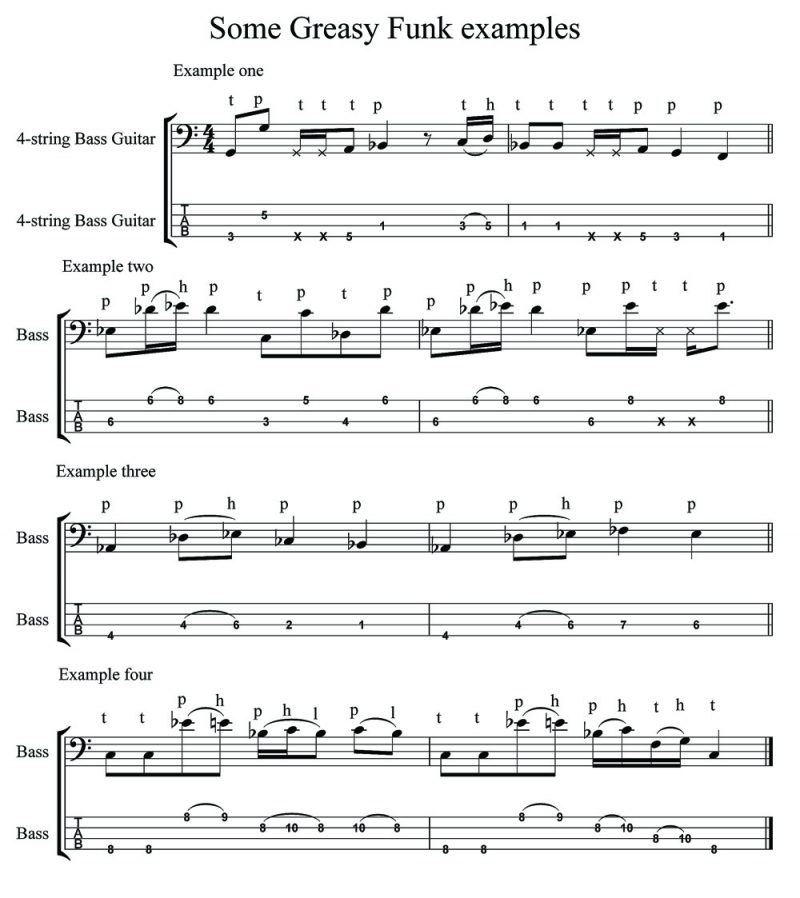Deep Thinking: Some Greasy Funk
Deep Thinking: Some Greasy Funk
As promised in the last NZM issue, we are going to do some slap exercises. These have a very slight difference from exercises I have written in the past – none of the riffs are in E or A!
All notes in the examples have letters ‘t’ (thumb), ‘p’ (pull), h (hammer-on), or ‘l’ (lift/pull-off) over them. When slapping in non-open string keys, fretting hand fingers that are not actually fretting notes have to be used for muting or for hammering dead notes.
Example 1 is a G minor riff that starts with a thumb/pull G to G octave. Quite often, I prefer to pull the lower note from underneath with my picking hand thumb rather than slap it. I stole this technique from a friend who plays claw-picking guitar and does the same thing on the low strings of his guitar with a plectrum or claw pick.
As usual, the ‘x’s mean thumb slapped dead notes, this time on your fourth string. The C to D is thumbed and then hammered. In short, with all four examples, when you see ‘t’, you can slap in the normal way or slide part of you thumb under the string and pull it. (I’ve marked ’p’ for lower strings in Examples 2 and 3.) This technique sounds very effective on the third and fourth strings as it adds a low percussive effect to the riff you are playing.
Example 2 is built around Eb mixolydian, a major scale with a flattened seventh note, a scale that sounds good in a variety of styles. This riff needs your picking thumb to go between strings 3 and 4. You should use the edge of it to slightly pull the third string Eb upward and release it before finger 1 pulls Db on string 1 and finger 3 hammers on to Eb an octave above.
You need to pull the Db once more before you play ‘disco’ style line slap thumbing and pulling C and Db octaves. The first half of bar 2 is the same as bar 1 but there are two dead notes in the second half that are played with your picking thumb while your fretting fingers mute the string.
Example 3 is in another unusual key for slap playing – Ab. Using the edge of your picking hand thumb, raise and release the low Ab on string 4 and then use the thumb to pull the Db and release it before hammering the Eb on string 3. You then do the same to the Cb (B) and Bb. Bar 2 has the same first half of the bar as bar 1, but you use the new thumb technique for the Fb (E) and Eb.
Example 4 is built from C mixolydian. Thumb the first two C’s at fret 8 on string 4 and then pull and hammer Eb to E natural on frets 9 to 10 on string 1.
The next group of three notes, Bb–C–Bb, is pulled, hammered and then lifted off with fingers 1 and 3 of your fretting hand on string 1.
The same technique is used for the last two notes on the bar – pull C and lift off to Bb. As in Example 3, the first half of bar 2 is the same as bar 1 but this phrase is followed by four sixteenth notes (semiquavers), pulled Bb to hammered C on frets 8 and 10 on string 2 and thumbed F to hammered G on frets 8 and 10 on string 3. The bar ends with a thumbed C on fret 8, string 4.
There are no tempos suggested. If you are new to slapping take the examples slowly, and don’t overdo it because you will get blisters. If you can already slap, these exercises are meant to get you slapping in different keys, so you should be able to have some fun playing in areas you might not have tried before.
(Dr. Rob Burns is an Associate Professor in Music at the University of Otago. As a former professional studio bassist in the UK, he performed and recorded with David Gilmour, Pete Townsend, Jerry Donahue, Isaac Hayes, Sam and Dave, James Burton, Ian Paice and Jon Lord, Eric Burdon and members of Abba. Rob is currently a member of Dunedin bands Subject2change and The Verlaines.)

